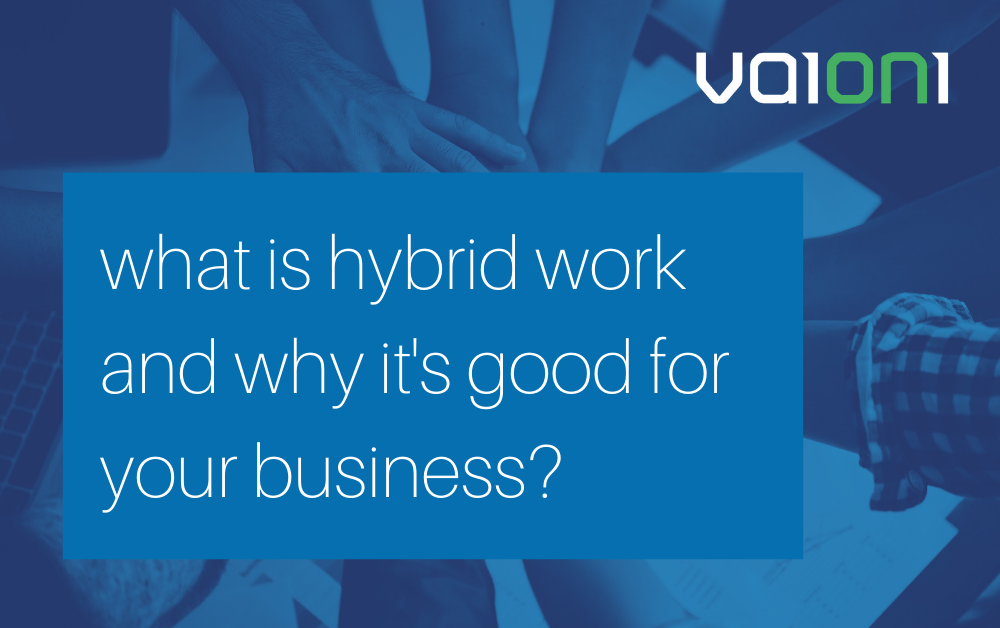When lockdown hit in March, thousands of us rushed away from workplaces and set up office in back bedrooms and garden sheds. It wasn’t ideal, but it was good enough. We made the best of it, despite cramped spaces, intrusive children and stuttering Zoom meetings.
And with the arrival of Covid’s second wave this Autumn, that’s the position many of us still find ourselves in. We’ve become used to remote working, though some of us want to go back to the office. Our expectations around work/life balance have changed. We’re looking forward to the end of the pandemic, but that doesn’t mean we want to wind back the clock to exactly the way things were before.
A new approach
Which is why you might have started hearing the term ‘hybrid working’ bandied about recently. It’s a new way of working that advocates a semi-remote approach, and generally means employees spend some of the week (post-Covid) in the office, and some of it working at home or elsewhere. It’s likely to prove popular. In Vaioni’s own post-Covid home working survey, only 8% of respondents said staff would continue to work from home all of the time after the pandemic, but 60% said their businesses would adopt a hybrid model.
The difference between hybrid and flexible working is that employees will have more autonomy to choose the working pattern that best suits their lives. In a few cases, that could mean working in the office all the time, or alternatively being a full time homeworker. But for most employees it is likely to involve a combination of both.
What are the benefits of hybrid working?
For employees, the benefits of the hybrid model are obvious. It’s easier to fit work around family life when you spend at least a couple of days a week working from home, and many workers will appreciate the opportunity to reduce weekly commute times. Employees will still head into the office for important meetings or to experience the social buzz, and many will want to.
For businesses, offering a hybrid model has the immediate benefit of attracting or retaining talented employees. On the whole, workers have enjoyed the upsides of home working during Covid and don’t want to give it up completely. Plenty of businesses will be offering hybrid working when the pandemic ends, and you probably don’t want to look like the one organisation stuck in the pre-pandemic past.
At the same time, office life is still important for the smooth running of most businesses, and getting teams together in the same building once or twice a week remains a valuable exercise. It’s good for team building, and also for creative collaboration. Observant team leaders will spot issues with motivation, or even an employee’s mental state, that would be hard to pick up remotely. Some employees simply don’t have homes that are conducive to productive work.
Research has shown that remote workers can be just as productive as office-bound colleagues, and in our own survey 56% of respondents said that they had been at least as productive at home as in the office (and in many cases more so). But experience suggests that bringing workers together in offices from time to time is hugely valuable, regardless of the size of your business or the sector you operate in. Hybrid working is quite literally the best of both worlds.
How to get hybrid working right
Or it is, if you get it right. Successful hybrid working requires a fundamental change of mindset, as well as some degree of digital transformation. Trust is vital. If you haven’t already, organisational leaders need to start judging employee worth by output and value, and not by how long workers spend at their desks. Staff need to be given clear objectives, and then trusted to work towards them in the way that suits them best.
After that, communication is key. Employees need to feel connected to the business, and integral to its success. That need will partly be met by time on site, which will be used for meetings, one-to-ones, and periods of team collaboration. But to avoid a sense of isolation, or a retreat into a silo of one, dispersed teams also need access to the tools and services that make formal and informal communication seamless.
In practical terms, that means staff need to be equipped to make voice and video calls, and join virtual meetings, from anywhere, and on any device. Text and instant messaging can encourage informal contacts, replacing the kind of ‘water cooler moments’ staff have in the office. If collaboration tools are built into your communication solution, so much the better.
Connect and thrive
It’s also essential that your connectivity matches your hybrid working ambitions. In the hybrid model, your office becomes the well connected hub for a fluid and dispersed workforce. The use of data-hungry cloud services, accessible from anywhere, will proliferate. You need to have adequate bandwidth for this digital-first approach (alongside a reliable security solution), though what that is will depend on what you do. A graphic designer uploading large design files to the cloud will need more bandwidth than an administrator using a cloud-based CRM platform for example. But businesses of all kinds have already run into a bandwidth buffer. In our own survey, 44% of respondents said they’d experienced connectivity and bandwidth issues when working from home.
So yes, transitioning to a hybrid working model is about changing your mindset and trusting your employees. But it’s also about equipping them with the tools they need to work, connect and collaborate, wherever they happen to be that day. The suitability of your digital infrastructure will be a crucial factor in how successfully your business exploits the obvious benefits of hybrid working.


